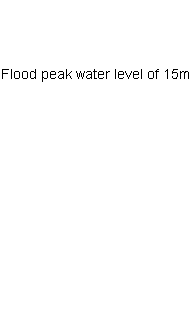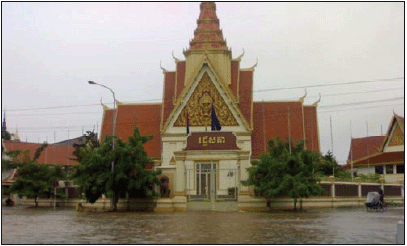4. Cambodia 2007 country report
4.1 General situation
Events in Cambodia during 2007 centred around the flooding caused by Tropical Storm Pabuk in the northern and coastal areas of the country on the 4th and 5th of August. Otherwise, the fact that the annual flood on the Mekong mainstream was a month late in starting and that water levels, once it had, remained significantly below average until October following ‘Lekima’, meant that levels in the Great Lake were considerably less than average. This delay in the increase in lake levels until early August and the fact that inundation of the riparian forest covered a much smaller area than usual resulted in a large fall in the annual fish catch.
4.2 Tropical Storm Pabuk during August and flooding in Phnom Penh in July
‘Pabuk’ resulted in some exceptional daily rainfall totals, as the data in Table 16 indicate, which in turn produced widespread flash floods and extensive inundation.
Table 16. Selected daily rainfalls
(mm) associated with Tropical Storm Pabuk. ![]()
| Date | Koh Kong | Mondulkiri | Preah Vihear | Ratnakiri | Stung Treng |
| 4th August | 174 | 102 | 0 | 21 | 38 |
| 5th August | 97 | 68 | 360 | 143 | 131 |
On the Sre Pok at Lumphat the maximum gauge height of 14 m was exceeded by the consequent flood peak (Figure 36 overpage). The most severe inundation occurred in Kampong Thom, Prah Vihear, Ratanakiri, Battambang and Sihanoukville. After a heavy rain for about an hour in the early morning of July 21 several places in Phnom Penh were inundated, principally due to the poor drainage infrastructure (Figure 36).
4.3 Damage and impacts
Reports from those provinces affected by ‘Pabuk’ during August indicate that more than 160,000 persons were affected, 5 people were killed, 37 km of rural roads were seriously eroded, along with some locally significant damage to public building, temples and residential areas. A number of dykes and irrigation canals filled with sediment or eroded. Over 8000 ha of rice and other crops were damaged or altogether lost due to prolonged submergence.

Figure 36. Sre Pok at Lumphat, maximum water level reached on the 7th August.

Figure 37. Flood inundation in Ratanakiri on 6th August
Figure 38. Phnom
Penh, flooding outside the National Assembly after
![]() intense
storm rainfall with a duration of 1 hour on 21st July.
intense
storm rainfall with a duration of 1 hour on 21st July.
4.4 Lessons learnt
The lessons learnt during the 2007 flood season in Cambodia reflect the issues that have needed to be addressed for some time:
- There is a need to put in place a systematic flood preparedness and emergency planning process at the provincial, district and commune level.
- The coordination between institutions and agencies concerned with flood planning and mitigation is limited.
- Access to flood information is poor.
- There is a lack of funds for hydrological data collection and the operation and maintenance of outstations.
- Interventions initiated by externally funded projects should not cease upon the completion of the project. Practical strategies that ensure the long term continuation of flood management and mitigation activities need to be developed at the national level.
- This lack of continuity does not permit the required levels of technical expertise be developed and retained.
Choose a newsletter:

